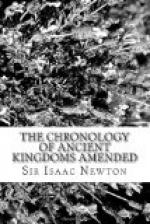At length the Egyptians, for the sake of Navigation, applied themselves to observe the Stars; and by their Heliacal Risings and Settings found the true Solar year to be five days longer than the Calendar year, and therefore added five days to the twelve Calendar months; making the Solar year to consist of twelve months and five days. Strabo [65] and [66] Diodorus ascribe this invention to the Egyptians of Thebes. The Theban_ Priests_, saith Strabo, are above others said to be Astronomers and Philosophers. They invented the reckoning of days not by the course of the Moon, but by the course of the Sun. To twelve months each of thirty days they add yearly five days. In memory of this Emendation of the year they dedicated the [67] five additional days to Osiris, Isis, Orus senior, Typhon, and Nephthe the wife of Typhon, feigning that those days were added to the year when these five Princes were born, that is, in the Reign of Ouranus, or Ammon, the father of Sesac: and in [68] the Sepulchre of Amenophis, who Reigned soon after, they placed a Golden Circle of 365 cubits in compass, and divided it into 365 equal parts, to represent all the days in the year, and noted upon each part the Heliacal Risings and Settings of the Stars on that day; which Circle remained there ’till the invasion of Egypt by Cambyses King of Persia. ’Till the Reign of Ouranus, the father of Hyperion, and grandfather of Helius and Selene, the Egyptians used the old Lunisolar year: but in his Reign, that is, in the Reign of Ammon, the father of Osiris or Sesac, and grandfather of Orus and Bubaste, the Thebans began to apply themselves to Navigation and Astronomy, and by the Heliacal Risings and Settings of the Stars determined the length of the Solar year; and to the old Calendar year added five days, and dedicated them to his five children above mentioned, as their birth days: and in the Reign of Amenophis, when by further Observations they had sufficiently determined the time of the Solstices, they might place the beginning of this new year upon the Vernal Equinox. This year being at length propagated into Chaldaea, gave occasion to the year of Nabonassar; for the years of Nabonassar and those of Egypt began on one and the same day, called by them Thoth, and were equal and in all respects the same: and the first year of Nabonassar began on the 26th day of February of the old Roman year, seven hundred forty and seven years before the Vulgar AEra of Christ, and thirty and three days and five hours before the Vernal Equinox, according to the Sun’s mean motion; for it is not likely that the Equation of the Sun’s motion should be known in the infancy of Astronomy. Now reckoning that the year of 365 days wants five hours




